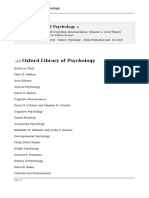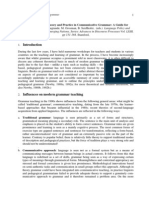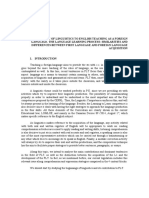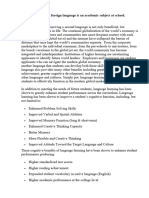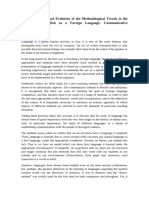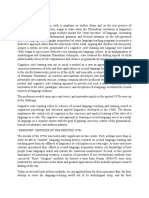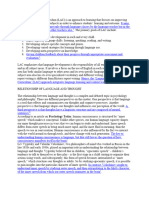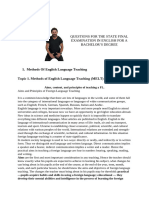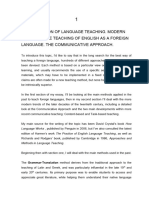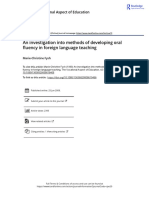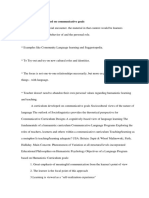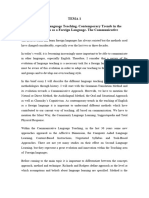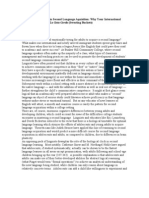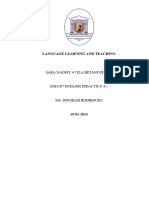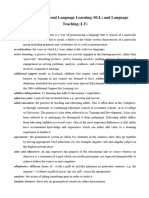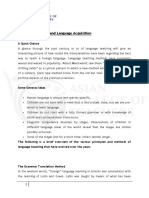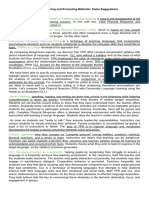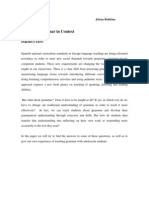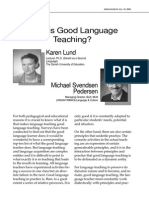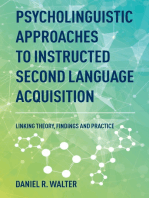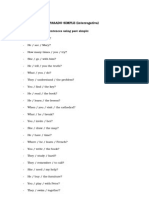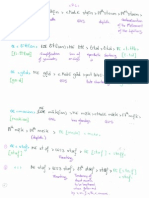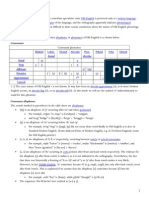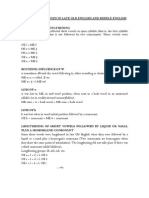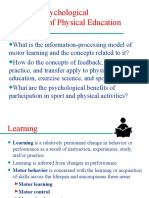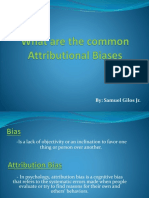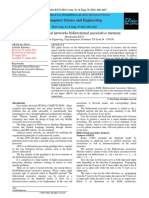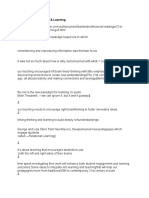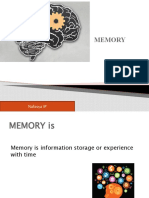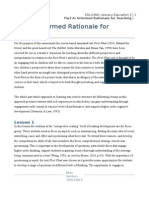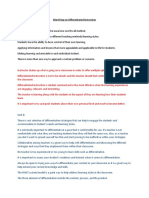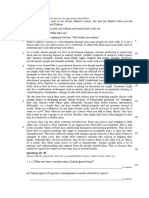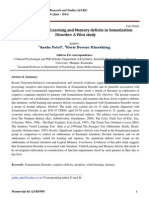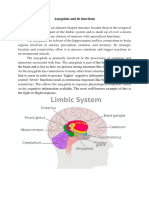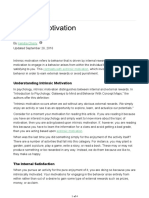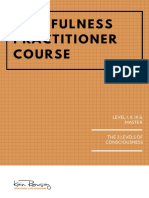Intercultural Mediator
Intercultural Mediator
Uploaded by
Tomatita89Copyright:
Available Formats
Intercultural Mediator
Intercultural Mediator
Uploaded by
Tomatita89Original Title
Copyright
Available Formats
Share this document
Did you find this document useful?
Is this content inappropriate?
Copyright:
Available Formats
Intercultural Mediator
Intercultural Mediator
Uploaded by
Tomatita89Copyright:
Available Formats
25- It might seem difficult enough to develop our students' linguistic competence, but these days much more
is demanded of a language teacher. Among other things, the teacher is supposed to be an intercultural mediator capable of introducing students to the differences in attitudes, beliefs, values, customs and behaviour between the native and the target cultures. In other words, especially within the state education system, language has more than instrumental value, and we need to make sure our students see the value "de la lengua extranjera como medio de comunicacin y entendimiento entre pueblos, facilitador del acceso a otras culturas, a otras lenguas y como enriquecimiento personal" as the Official Curriculum puts it. Much of the drive behind this aim comes from European policy-makers, who see language teaching and learning as essential to the formation of a cross-cultural European identity. You might want to think about how Spanish culture differs from British or American culture with respect to attitudes, values, beliefs and behaviour. You should also think about how we might focus on intercultural differences in the classroom, and how we might encourage our students to reflect critically on these differences. I have uploaded an extract from a text by Michael Byram, a key European theorist in this area, and a copy of the introduction to the curriculum for Bachillerato, in which we can see the importance attached to conciencia intercultural by the Spanish education authorities. 26- Discourse analysts study language in use - spoken or written language produced for a communicative purpose between two or more interlocutors in a real context. Any real use of language can be the object of discourse analysis - doctor-patient interviews, letters to the editor, religious sermons, text messages between teenagers. The discourse context influences and sometimes determines our intonation, vocabulary, and grammar and affects both the form and content of our messages. The basic idea is that language use is in principle addressee-oriented. In writing this text, for example, I have in mind non-native speaker students of English who have attended the class devoted to this topic. As teachers we need to encourage students to do more than produce and understand the literal meaning of English sentences. You can be brilliant at producing correrct sentences and still write a terrible application for a job. 27- The concept of communicative competence has had a profound impact on ideas about language teaching over the last thirty years. Originating in sociolinguistics, it is now taken for granted that the langauge teacher is concerned not only to develop the learners linguistic competence but also other competences. The interest in these has developed in parallel with the emergence of sociolinguistics, pragmatics and other disciplines, apart from the ideea of strategic competence - which enables us to use various strategies to keep an interaction going. The result is that the communicative classroom looks very different from the traditional classroom - in addition to teaching vocabulary and sentence-level grammatical forms, we now teach students how to use language - how to speak appropriately as well as correctly, how to construct whole texts, how to participate in conversations, etc. 28- Two main theoretical developments have influenced language teaching in the last thirty years - the idea of language as communication and the hypothesis that the learning of a second or foreign language is similar to the acquisition of the mother tongue. Research into first language acquisition developed from Chomsky's mentalistic grammar and the concept of creative construction. Language acquistion is based not on imitation but on the construction, through exposure to the language, of a mental representation of the syntax of that language. This process is essentially internally driven - it takes place unconsciously, without formal instruction, through participating in interactions with parents and siblings. There appears to be a more or less universal sequence in which the grammar of the language is acquired. 29 and 30- A question of fundamental importance is whether first and second language acquisition are similar or not. If the most efficient way of acquiring a second language resembles the way we acquired
our first, the classroom should attempt to replicate, as far as possible, the natural processes of language acquisition. However, it is not obvious that in most cases this will be possible. Naturalistic L2 acquisition by children, it is true, is very similar to first language acquisition, but L2 foreign language learning in a classroom for a couple of hours a week is not. The most prominent proponent of the similiarity between first and second language acquisition is Stephen Krashen. For Krashen, the teacher's main task was to provide the learners with comprehensible input, which would provide the means for them to construct their representation of the grammar of the foreign language. In Krashen's Natural Approach, the focus is on comprehension activities, while formal focus on language is avoided. Unconscious acquisition hs priority over formal learning, This was an attractive and influential idea, but was predictably found to over-simplify the process of acquiring a second, and in particular, a foreign language. Krashen, however, is worth reading and you 31- Among the key concepts in SLA theory is that of interlanguage. Language learners form a complex mental representation of the syntax of the target language based on rules derived both from their first language and from the target language. Learners appear to move through a more or less universal developmental sequence and display characteristic errors at each stage. Some of these are interlingual derived from the L1 - and some are intralingual - based on the target language. Errors are inevitable in normal language learning, are a sign of the learner's developing interlanguage, and are valuable for the teacher, as they allow her to identify the stage of language acquisition that the learner has reached. 32- The dominant orthodoxy in current SLA studies is termed focus on form. Proponents of this idea, most notably Michael Long, believe, like Krashen, that first and second language acqusition are similar. However, the experience of learners in immersion programmes demonstrated that some kind of formal focus on language is essential in second language acquisition. However, this cannot consist of formal lessons devoted to language, as the human brain is not equipped (so they claim) to acquire language in this way. What they propose is a programme based on communicative tasks and activities, with a lot of aural and written input, supplemented by a focus on small items of language where absolutely necessary - most importantly when communication in the classroom breaks down. For example, if students have to follow instructions in order to draw a picture of a room, they might have a problem with the prepositions in and on, and the teacher might give a short explanation of the difference between them, after thea ctivity has taken place. There is an alternative idea, which I find attractive for foreign language learning situations. This is called focus on forms and sees language learning as skill learning, which involves an initial presentation by the teacher, controlled practice and feedback and then an attempt to use the new language in a communicative task. Note that both approaches see communicative activities as central to the learning processes. The focus on forms approach, however, is more inclusive, as it not against incidental focus on form, but wants to supplement it with a more structured approach to the presentation of new material. What few theorists would defend today is the kind of classroom in which learners progress through a series of grammar lessons with little attempt to give them opportunities to use the new language in communication.
You might also like
- The Oxford Handbook of Cognitive Neuroscience, Vol. 1 PDFDocument1,111 pagesThe Oxford Handbook of Cognitive Neuroscience, Vol. 1 PDFandrewlan000No ratings yet
- 1david Newly Com GramDocument13 pages1david Newly Com GramMbagnick DiopNo ratings yet
- l2 Teaching Methods and ApproachesDocument22 pagesl2 Teaching Methods and ApproachesCarlos Fernández PrietoNo ratings yet
- TEFL Entrance ExamDocument3 pagesTEFL Entrance ExammerekNo ratings yet
- Past ContinuousDocument2 pagesPast ContinuousTomatita89100% (1)
- 6 Contributions of LinguisticsDocument4 pages6 Contributions of LinguisticsTeresa Pajarón LacaveNo ratings yet
- Метод 1-11Document12 pagesМетод 1-11Айым КайратоваNo ratings yet
- Summary Tefl Bab 1..Document4 pagesSummary Tefl Bab 1..Cerli MarsitaNo ratings yet
- Unit 1: Introduction: Pre-Chapter QuestionsDocument116 pagesUnit 1: Introduction: Pre-Chapter QuestionsFranco KaaminoNo ratings yet
- Psycho Linguistics ArticleDocument11 pagesPsycho Linguistics Articlehtgjuni535No ratings yet
- T1Document15 pagesT1Alicia DíezNo ratings yet
- Aims and Objectives in Teaching English in SchoolsDocument11 pagesAims and Objectives in Teaching English in SchoolsDoina CaramanNo ratings yet
- T2Document12 pagesT2Alicia DíezNo ratings yet
- Cognitive CodeDocument10 pagesCognitive CodeHendianaMustofa100% (2)
- Summarize: Common Method of Teaching English For Specific PurposeDocument12 pagesSummarize: Common Method of Teaching English For Specific Purposeanna marthinneNo ratings yet
- Topic 6Document3 pagesTopic 6Rebeca RodríguezNo ratings yet
- Lesson - 4 Cognitive ApproachDocument11 pagesLesson - 4 Cognitive ApproachRonalene Manguerra100% (1)
- Language Across The CurriculumDocument3 pagesLanguage Across The CurriculumdzedziphillyNo ratings yet
- Discourse Analysis and Language Teaching Meta 1.4 summerizing (1)Document6 pagesDiscourse Analysis and Language Teaching Meta 1.4 summerizing (1)Horacio Peraza 愛No ratings yet
- Rákos-államvizsgaDocument93 pagesRákos-államvizsgaEmail PotNo ratings yet
- Tema 1 ResumenDocument7 pagesTema 1 Resumenmespadac05No ratings yet
- An Investigation Into Methods of Developing Oral Fluency in Foreing Language TeachingDocument6 pagesAn Investigation Into Methods of Developing Oral Fluency in Foreing Language TeachingLeví LunaNo ratings yet
- A Curriculum Development1Document9 pagesA Curriculum Development1Lumaad Hotrini Elianna YunitaNo ratings yet
- Learning-Centered MethodsDocument19 pagesLearning-Centered MethodsPourya HellNo ratings yet
- Tema 1Document5 pagesTema 1y.lysyanskyy.lsgiNo ratings yet
- Final Exam SociolinguisticsDocument14 pagesFinal Exam SociolinguisticsKANISKA A/P MAYALAGAN STUDENTNo ratings yet
- The Scope of Psycholinguistics Studies and The SigDocument9 pagesThe Scope of Psycholinguistics Studies and The SigAdhi Jaya Chucha ChoChesNo ratings yet
- Psychological Factors in Second Language AquisitionDocument4 pagesPsychological Factors in Second Language AquisitionGustiana MettasariNo ratings yet
- Tema 06 BDocument7 pagesTema 06 BTani MurollNo ratings yet
- Linguistics in Reading (Final Exam)Document12 pagesLinguistics in Reading (Final Exam)Bonjovi HajanNo ratings yet
- KramsDocument16 pagesKramsWilson LopezNo ratings yet
- Tema 14 MagisterioDocument7 pagesTema 14 MagisterioMvp LoloNo ratings yet
- Tema 13Document6 pagesTema 13LaiaNo ratings yet
- Tu Luan ALDocument7 pagesTu Luan ALtriocattenNo ratings yet
- FELT-LESSON-1Document5 pagesFELT-LESSON-1MarsNo ratings yet
- Language Acquisition Dissertation TopicsDocument7 pagesLanguage Acquisition Dissertation TopicsPurchaseCollegePapersUK100% (1)
- Language, Culture and LearningDocument22 pagesLanguage, Culture and LearningCao Thuy Hong100% (2)
- Communicative ApproachDocument7 pagesCommunicative ApproachAshe SoltanovaNo ratings yet
- лекцииDocument48 pagesлекцииАкнурNo ratings yet
- TEMA 1 Oposición Profesor Inglés 2021Document8 pagesTEMA 1 Oposición Profesor Inglés 2021Álvaro HPNo ratings yet
- 2 - General Theories About Learning and Acquisition of A Foreign LanguageDocument5 pages2 - General Theories About Learning and Acquisition of A Foreign LanguageRobertoNo ratings yet
- Language Learning and Teaching Sara AvilaDocument4 pagesLanguage Learning and Teaching Sara AvilaSara Naomy AvilaNo ratings yet
- Didactic Dictionary 1Document22 pagesDidactic Dictionary 1Almudena NidoNo ratings yet
- Language Learning VS Acquisition1Document64 pagesLanguage Learning VS Acquisition1lottaNo ratings yet
- Make Up SummariesDocument11 pagesMake Up SummariesPri CanchiNo ratings yet
- Ptlal ReviewerDocument7 pagesPtlal Reviewererikakimperez7No ratings yet
- CULTUREDocument5 pagesCULTURESheryn AstibeNo ratings yet
- Communicative Approach (CLT)Document4 pagesCommunicative Approach (CLT)David Burda100% (1)
- Teaching Grammar in ContextDocument18 pagesTeaching Grammar in ContextJelena Bobkina100% (4)
- 12Document6 pages12Lucía RGNo ratings yet
- 2211074139ENG0816ELT Unit 2... Part 1elt Unit 2 Part 1Document5 pages2211074139ENG0816ELT Unit 2... Part 1elt Unit 2 Part 1bergeshussain86No ratings yet
- Topic 6Document12 pagesTopic 6Francesca Bruera Perez100% (8)
- Topic 1. Didactic Evolution of Foreign Language TeachingDocument7 pagesTopic 1. Didactic Evolution of Foreign Language TeachingBlancaNo ratings yet
- Second Language Vocabulary Acquisition ThesisDocument5 pagesSecond Language Vocabulary Acquisition Thesisbk1hxs86100% (2)
- Characterizing The Essentials of Methods: Language Focus: Speech Communication vs. LiteratureDocument7 pagesCharacterizing The Essentials of Methods: Language Focus: Speech Communication vs. LiteraturePourya Hell100% (1)
- What Is Morphosyntax?: The Relationship Between Age and Second Language Productive AbilityDocument8 pagesWhat Is Morphosyntax?: The Relationship Between Age and Second Language Productive AbilityAlvin Rañosa LimNo ratings yet
- Lund & Svedsen (2001) What Is Good Language TeachingDocument4 pagesLund & Svedsen (2001) What Is Good Language TeachingLaura Natalia Valbuena Peña100% (1)
- The language dimension in all subjects: A handbook for curriculum development and teacher trainingFrom EverandThe language dimension in all subjects: A handbook for curriculum development and teacher trainingNo ratings yet
- Bilingual Competence and Bilingual Proficiency in Child DevelopmentFrom EverandBilingual Competence and Bilingual Proficiency in Child DevelopmentNo ratings yet
- Psycholinguistic Approaches to Instructed Second Language Acquisition: Linking Theory, Findings and PracticeFrom EverandPsycholinguistic Approaches to Instructed Second Language Acquisition: Linking Theory, Findings and PracticeNo ratings yet
- Using Home Language as a Resource in the Classroom: A Guide for Teachers of English LearnersFrom EverandUsing Home Language as a Resource in the Classroom: A Guide for Teachers of English LearnersNo ratings yet
- Cuadro Verbos IrregularesDocument3 pagesCuadro Verbos IrregularesTomatita89No ratings yet
- Repoted Speech Rephrasings 2Document2 pagesRepoted Speech Rephrasings 2Tomatita89No ratings yet
- Departamento de Idiomas: Inglés Ejercicios Refuerzo FechaDocument2 pagesDepartamento de Idiomas: Inglés Ejercicios Refuerzo FechaTomatita89No ratings yet
- Qué Tiempo Verbal EsDocument3 pagesQué Tiempo Verbal EsTomatita89No ratings yet
- Departamento de Idiomas: Inglés Ejercicios Refuerzo FechaDocument2 pagesDepartamento de Idiomas: Inglés Ejercicios Refuerzo FechaTomatita89No ratings yet
- PASADO SIMPLE (Interrogativa) : 1.-Write Interrogative Sentences Using Past SimpleDocument1 pagePASADO SIMPLE (Interrogativa) : 1.-Write Interrogative Sentences Using Past SimpleTomatita89No ratings yet
- U S.BC,:?,: T,)Document2 pagesU S.BC,:?,: T,)Tomatita89No ratings yet
- Pasado Continu oDocument1 pagePasado Continu oTomatita89No ratings yet
- Seen? Ever SeenDocument3 pagesSeen? Ever SeenTomatita89No ratings yet
- Have To y Pasado ContinuoDocument3 pagesHave To y Pasado ContinuoTomatita89No ratings yet
- Modal Auxiliary Verbs. Fill in The Blanks With The Appropriate Modal VerbDocument2 pagesModal Auxiliary Verbs. Fill in The Blanks With The Appropriate Modal VerbTomatita89No ratings yet
- ' (FL-GK,: Tif D, T 5Document4 pages' (FL-GK,: Tif D, T 5Tomatita89No ratings yet
- Old English PhonologyDocument19 pagesOld English PhonologyTomatita89100% (1)
- Dependent Changes in Late Old English and Middle EnglishDocument2 pagesDependent Changes in Late Old English and Middle EnglishTomatita89No ratings yet
- Ejercicio Ordenar Frases x3 M y MJDocument1 pageEjercicio Ordenar Frases x3 M y MJTomatita89No ratings yet
- Chapter 9: Psychological Foundations of Physical Education and SportDocument36 pagesChapter 9: Psychological Foundations of Physical Education and SportGinaDyoSalsabilaNo ratings yet
- Attributional Biases GilosDocument8 pagesAttributional Biases GilosJike AlabadoNo ratings yet
- Appraisal Form #1: Checklist On Classroom ManagementDocument5 pagesAppraisal Form #1: Checklist On Classroom ManagementJoan Ibay AntolinNo ratings yet
- Artificial Neural Networks Bidirectional Associative Memory: Computer Science and EngineeringDocument3 pagesArtificial Neural Networks Bidirectional Associative Memory: Computer Science and EngineeringSohail AnsariNo ratings yet
- A Cognitive System Model For Human/Automation Dynamics in Airspace ManagementDocument15 pagesA Cognitive System Model For Human/Automation Dynamics in Airspace Managementnyana07No ratings yet
- A Detailed Lesson Plan in ECE 10Document5 pagesA Detailed Lesson Plan in ECE 10Jasmin P Pagador100% (2)
- 21st CenturyDocument2 pages21st CenturyNathaniel Edrote RemotigueNo ratings yet
- Memory: Nafasya IPDocument20 pagesMemory: Nafasya IPNafasya Intan PrabandiniNo ratings yet
- At2 Rationale For TeachingDocument4 pagesAt2 Rationale For Teachingapi-284319044No ratings yet
- Makalah Kelompok PsycholinguisticDocument7 pagesMakalah Kelompok Psycholinguisticsidqy radinalNo ratings yet
- Mind Map On Differentiated InstructionDocument2 pagesMind Map On Differentiated Instructionapi-532859914No ratings yet
- Decision Making Can Be Viewed As An Eight-Step Process That Involves IdentifyingDocument5 pagesDecision Making Can Be Viewed As An Eight-Step Process That Involves Identifyingnavimala85No ratings yet
- Objectives of Teaching EnglishDocument4 pagesObjectives of Teaching EnglishAarthi RajakumarNo ratings yet
- ACT-R Intro TutorialDocument64 pagesACT-R Intro TutorialSoheil EngineerNo ratings yet
- Teaching-Learning Process and Curriculum DevelopmentDocument19 pagesTeaching-Learning Process and Curriculum DevelopmentCestlavi SantosNo ratings yet
- Psicoterapia Sensoriomotora PDFDocument974 pagesPsicoterapia Sensoriomotora PDFJosé Luis SH100% (4)
- Information Literacy ExplainedDocument15 pagesInformation Literacy ExplainedrustoryhufNo ratings yet
- Read This Passage and Then Answer The Questions That FollowDocument3 pagesRead This Passage and Then Answer The Questions That FollowWong MkNo ratings yet
- Attention, Verbal Learning and Memory Deficits in Somatization DisorderDocument21 pagesAttention, Verbal Learning and Memory Deficits in Somatization Disordertaneja_rahul82No ratings yet
- Imrad Listening Vladimir (New)Document5 pagesImrad Listening Vladimir (New)Kenju NuedaNo ratings yet
- Math Lesson-Dividing Whole NumbersDocument3 pagesMath Lesson-Dividing Whole Numbersapi-293900669No ratings yet
- Lecture - Amygdala and Its FunctionsDocument8 pagesLecture - Amygdala and Its Functionsproblemchik2003100% (1)
- ATL AssignmentDocument10 pagesATL AssignmentMaritza Román RodríguezNo ratings yet
- Social Learning TheoryDocument1 pageSocial Learning TheorySherry Mae ArmadaNo ratings yet
- Understanding Intrinsic Motivation: Kendra CherryDocument4 pagesUnderstanding Intrinsic Motivation: Kendra CherryRajAnandNo ratings yet
- Designing A VisualizationDocument5 pagesDesigning A VisualizationAbdul HafeezNo ratings yet
- Teaching and Learning Activities Were Postponed Because of A/an - Lesson Was Forwarded ToDocument2 pagesTeaching and Learning Activities Were Postponed Because of A/an - Lesson Was Forwarded ToFarah NadiaNo ratings yet
- Rethinking Learning: Carl Bereiter Marlene ScardamaliaDocument23 pagesRethinking Learning: Carl Bereiter Marlene ScardamaliaJ. Félix Angulo RascoNo ratings yet
- Mindfulness Practitioner Course: Level I, Ii, Iii & Master The 3 Levels of ConsciousnessDocument5 pagesMindfulness Practitioner Course: Level I, Ii, Iii & Master The 3 Levels of ConsciousnessTamoghna RokadeNo ratings yet

